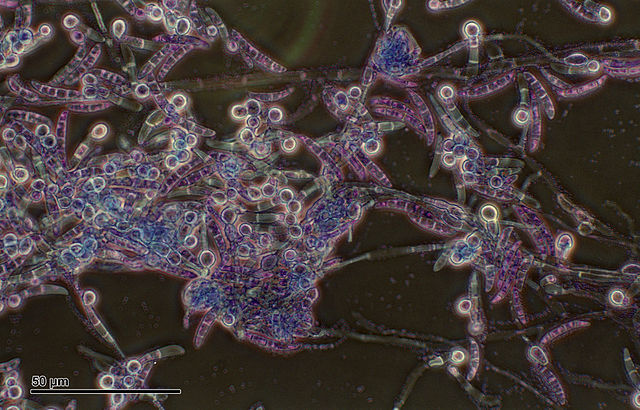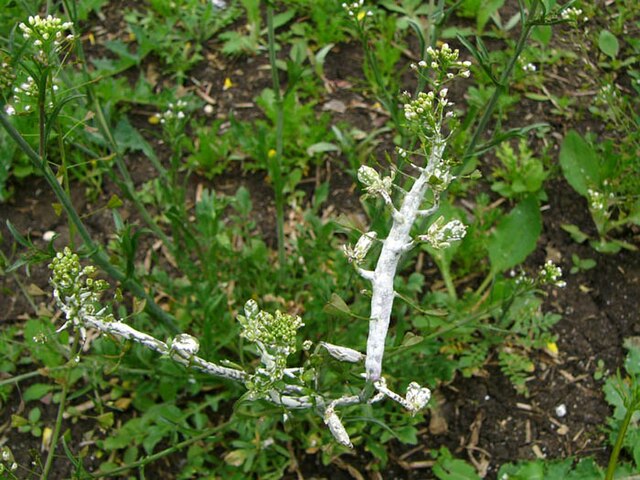Downy mildew refers to any of several types of oomycete microbes that are obligate parasites of plants. Downy mildews exclusively belong to the Peronosporaceae family. In commercial agriculture, they are a particular problem for growers of crucifers, grapes and vegetables that grow on vines. The prime example is Peronospora farinosa featured in NCBI-Taxonomy and HYP3. This pathogen does not produce survival structures in the northern states of the United States, and overwinters as live mildew colonies in Gulf Coast states. It progresses northward with cucurbit production each spring. Yield loss associated with downy mildew is most likely related to soft rots that occur after plant canopies collapse and sunburn occurs on fruit. Cucurbit downy mildew only affects leaves of cucurbit plants.
Example of downy mildew (left) along with powdery mildew on a grape leaf
The Oomycetes, or Oomycota, form a distinct phylogenetic lineage of fungus-like eukaryotic microorganisms within the Stramenopiles. They are filamentous and heterotrophic, and can reproduce both sexually and asexually. Sexual reproduction of an oospore is the result of contact between hyphae of male antheridia and female oogonia; these spores can overwinter and are known as resting spores. Asexual reproduction involves the formation of chlamydospores and sporangia, producing motile zoospores. Oomycetes occupy both saprophytic and pathogenic lifestyles, and include some of the most notorious pathogens of plants, causing devastating diseases such as late blight of potato and sudden oak death. One oomycete, the mycoparasite Pythium oligandrum, is used for biocontrol, attacking plant pathogenic fungi. The oomycetes are also often referred to as water molds, although the water-preferring nature which led to that name is not true of most species, which are terrestrial pathogens.
![Sexual structures (only oogonia, antheridia not shown) of Saprolegnia.[citation needed]](https://upload.wikimedia.org/wikipedia/commons/thumb/e/ef/Oomy1002L.jpg/640px-Oomy1002L.jpg)
Sexual structures (only oogonia, antheridia not shown) of Saprolegnia.[citation needed]
Pythium sp. (Peronosporales), which causes pythiosis in animals, under microscope.
Symptom of late blight (P. infestans, Peronosporales) on the underside of a potato leaf.
Albugo candida (Albuginales) on shepherd's purse (Capsella bursa-pastoris, Brassicales).


![Sexual structures (only oogonia, antheridia not shown) of Saprolegnia.[citation needed]](https://upload.wikimedia.org/wikipedia/commons/thumb/e/ef/Oomy1002L.jpg/640px-Oomy1002L.jpg)


